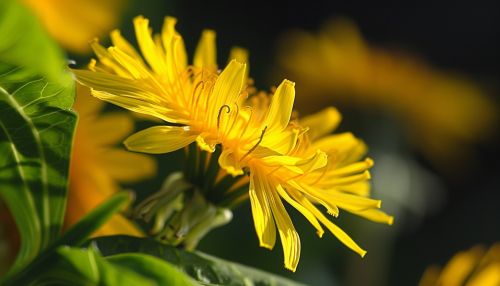Dandelion
Taxonomy and Etymology
The dandelion, scientifically known as Taraxacum officinale, belongs to the Asteraceae family, which is one of the largest families of flowering plants. The genus name Taraxacum is derived from the Greek words "taraxos" (disorder) and "akos" (remedy), indicating its historical use in herbal medicine. The species name officinale refers to its official recognition as a medicinal plant. The common name "dandelion" is a corruption of the French "dent de lion" meaning "lion's tooth", a reference to the jagged edges of the dandelion leaf.
Description
Dandelions are perennial plants, characterized by their bright yellow flowers and distinctive seed heads, known as "dandelion clocks". The plant typically grows between 5 and 40 cm in height, with deeply toothed, lance-shaped leaves. The flower heads are solitary and borne on hollow stalks. Each flower head is actually a composite of many tiny flowers, or florets. After pollination, the flower head transforms into a globe of fine filaments, each carrying a seed.


Distribution and Habitat
Dandelions are native to Europe and Asia, but have since spread to many parts of the world, including North and South America, Australia, and New Zealand. They are highly adaptable and can grow in a variety of habitats, from meadows and grasslands to urban areas. They are often considered a weed in lawns and gardens due to their invasive nature and rapid reproduction.
Reproduction
Dandelions reproduce both sexually and asexually. The sexual reproduction occurs through cross-pollination, facilitated by insects such as bees. Asexually, dandelions reproduce through apomixis, a process in which seeds are produced without fertilization. This results in offspring that are genetically identical to the parent plant. The seeds are dispersed by wind, a mechanism known as anemochory.
Ecology
Dandelions play an important role in the ecosystem. They provide an early source of pollen and nectar for bees and other pollinators in the spring. Their deep roots help to break up compacted soil, improving soil structure and nutrient cycling. Furthermore, they serve as a food source for various animals, including birds, insects, and mammals.
Cultivation
Dandelions are cultivated for their culinary and medicinal uses. They are hardy plants that can grow in a wide range of soil types, although they prefer well-drained, fertile soil with full sun exposure. They can be propagated from seed or by root division.
Uses
Dandelions have been used for centuries in various cultures for their medicinal and nutritional properties. The leaves, flowers, and roots are all edible and are often used in salads, teas, wines, and other culinary preparations. Medicinally, dandelions have been used to treat a variety of ailments, including digestive disorders, liver diseases, and skin conditions. They are also used in traditional Chinese medicine and Ayurveda.
